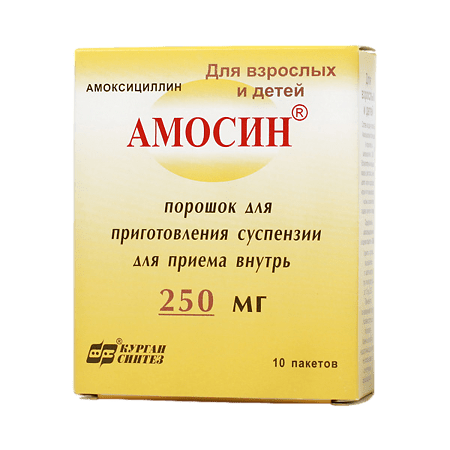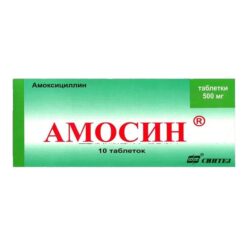No products in the cart.
Amosin, 250 mg/3 g 10 pcs.
€2.32 €2.11
Out of stock
(E-mail when Stock is available)
Description
Pharmacotherapeutic group
Antibiotic, semi-synthetic penicillin
ATC code: J01CA04
Pharmacodynamics:
A broad-spectrum antibacterial bactericidal acid-resistant agent from the group of semisynthetic penicillins. It inhibits transpeptidase disrupts synthesis of peptidoglycan (support protein of cell wall) during division and growth causing lysis of bacteria. Active against aerobic Gram-positive bacteria: Staphylococcus spp. (except for penicillinase-producing strains) Streptococcus spp; and aerobic Gram-negative bacteria: Neisseria gonorrhoeae Neisseria meningitidis Escherichia coli Shigella spp. Salmonella spp. Klebsiella spp. Microorganisms producing penicillinase are resistant to the action of amoxicillin. Action develops 15-30 minutes after administration and lasts for 8 hours.
Pharmacokinetics:
Absorption – fast high (93%) food intake has no effect on absorption is not destroyed in the acidic environment of the stomach. When administered orally in doses of 125 and 250 mg, the maximum concentration is 1.5-3 mcg/ml and 3.5-5 mcg/ml, respectively. Time to maximum concentration after oral administration is 1-2 hours. It has a large volume of distribution – high concentrations are found in plasma sputum bronchial secretion (poor distribution in purulent bronchial secretion) pleural and peritoneal fluid urine contents of skin blister tissue lung tissue intestinal mucosa female genital organs prostate middle ear fluid bone adipose tissue gallbladder (with normal liver function) fetal tissues.
The concentration also increases by a factor of 2 when the dose is increased by a factor of 2. The concentration in bile is 2-4 times higher than in plasma. In amniotic fluid and umbilical cord vessels, the concentration of amoxicillin is 25-30% of the level in plasma of a pregnant woman. Poorly penetrates through the blood-brain barrier in inflammation of the meninges (meningitis), the concentration in cerebrospinal fluid is about 20%. Binding with plasma proteins is 17%.
Partially metabolized to form inactive metabolites. Half-life period is 1-1.5 hours. It is eliminated 50-70% unchanged by kidneys through tubular excretion (80%) and glomerular filtration (20%) by liver – 10-20%. A small amount is excreted with breast milk. Half-life in premature infants and children up to 6 months is 3-4 hours. With impaired renal function (creatinine clearance less than or equal to 15 ml/min) the half-life is increased to 8.5 hours. Amoxicillin is eliminated with hemodialysis.
Indications
Indications
Bacterial infections caused by sensitive microflora:
infections of the respiratory tract and ENT organs (sinusitis pharyngitis tonsillitis acute otitis media; bronchitis pneumonia), genitourinary system (pyelonephritis pyelitis cystitis urethritis gonorrhea endometritis cervicitis), gastrointestinal tract (peritonitis enterocolitis typhoid fever cholangitis cholecystitis), infections of the skin and soft tissues (erysipelas impetigo secondary infected dermatoses), leptospirosis, listeriosis, Lyme disease (borreliosis), dysentery, salmonellosis, salmonella carriage, meningitis, endocarditis (prevention), sepsis.
Pharmacological effect
Pharmacological effect
Pharmacotherapeutic group
Antibiotic, semi-synthetic penicillin
ATX code: J01CA04
Pharmacodynamics:
Antibacterial, bactericidal, acid-resistant, broad-spectrum agent from the group of semi-synthetic penicillins. Inhibits transpeptidase, disrupts the synthesis of peptidoglycan (supporting protein of the cell wall) during the period of division and growth, causing lysis of bacteria. Active against aerobic gram-positive bacteria: Staphylococcus spp. (except for strains producing penicillinase) Streptococcus spp; and aerobic gram-negative bacteria: Neisseria gonorrhoeae Neisseria meningitidis Escherichia coli Shigella spp. Salmonella spp. Klebsiella spp. Microorganisms producing penicillinase are resistant to amoxicillin. The action develops 15-30 minutes after administration and lasts 8 hours.
Pharmacokinetics:
Absorption – fast high (93%) food intake has no effect on absorption and is not destroyed in the acidic environment of the stomach. When taken orally at a dose of 125 and 250 mg, the maximum concentration is 1.5-3 mcg/ml and 3.5-5 mcg/ml, respectively. The time to reach maximum concentration after oral administration is 1-2 hours. It has a large volume of distribution – high concentrations are found in plasma, sputum, bronchial secretions (in purulent bronchial secretions, the distribution is weak) pleural and peritoneal fluid, urine, contents of skin blisters, lung tissue, intestinal mucosa, female genital organs, prostate gland, middle ear fluid, bones, adipose tissue, gall bladder (with normal liver function) tissues fetus
When the dose is doubled, the concentration also doubles. The concentration in bile exceeds the concentration in plasma by 2-4 times. In the amniotic fluid and umbilical cord vessels, the concentration of amoxicillin is 25-30% of the level in the plasma of a pregnant woman. Poorly penetrates the blood-brain barrier during inflammation of the meninges (meningitis); the concentration in the cerebrospinal fluid is about 20%. Communication with plasma proteins – 17%.
Partially metabolized to form inactive metabolites. The half-life is 1-1.5 hours. It is excreted 50-70% unchanged by the kidneys by tubular excretion (80%) and glomerular filtration (20%) and 10-20% by the liver. A small amount is excreted in breast milk. The half-life in premature newborns and children under 6 months is 3-4 hours. If renal function is impaired (creatinine clearance is less than or equal to 15 ml/min), the half-life increases to 8.5 hours. Amoxicillin is removed by hemodialysis.
Special instructions
Special instructions
During a course of treatment, it is necessary to monitor the state of the function of the hematopoietic organs of the liver and kidneys.
It is possible that superinfection may develop due to the growth of microflora that is insensitive to it, which requires a corresponding change in antibacterial therapy.
When treating patients with bacteremia, the development of a bacteriolysis reaction (Jarisch-Herxheimer reaction) is possible.
In patients with hypersensitivity to penicillins, cross-allergic reactions with cephalosporin antibiotics are possible.
When treating mild diarrhea during a course of treatment, antidiarrheal drugs that reduce intestinal motility should be avoided; You can use kaolin- or attapulgite-containing antidiarrheal agents. If diarrhea is severe, consult a doctor.
Treatment must continue for another 48-72 hours after the disappearance of clinical signs of the disease.
When using estrogen-containing oral contraceptives and amoxicillin simultaneously, other or additional methods of contraception should be used.
Active ingredient
Active ingredient
Amoxicillin
Composition
Composition
1 sachet contains:
Active substance:
amoxicillin trihydrate (in terms of amoxicillin) – 0.250 g.
Excipients: polyvinylpyrrolidone (povidone), glucose (dextrose), disodium ethylenediamine salt N,N,N’,N’-Tetraoxyacid 2-aqueous (trilon B) (disodium edetate), sodium phosphate disubstituted (sodium hydrogen phosphate), sodium α-glutamic acid 1-aqueous, food flavoring, vanillin, sugar (sucrose).
Contraindications
Contraindications
Hypersensitivity (including to other penicillins, cephalosporins, carbapenems) allergic diathesis bronchial asthma hay fever infectious mononucleosis lymphocytic leukemia liver failure history of gastrointestinal diseases (especially colitis associated with the use of antibiotics) lactation period.
With caution:
Pregnancy, renal failure, history of bleeding.
Side Effects
Side Effects
Allergic reactions: possible urticaria, skin hyperemia, erythema, angioedema, rhinitis, conjunctivitis; rarely – fever, joint pain, eosinophilia, exfoliative dermatitis, exudative erythema multiforme, Stevens-Johnson syndrome; reactions similar to serum sickness; in isolated cases – anaphylactic shock.
From the digestive system: dysbacteriosis, change in taste, vomiting, nausea, diarrhea, stomatitis, glossitis, liver dysfunction, moderate increase in the activity of “liver” transaminases, pseudomembranous enterocolitis.
From the nervous system: agitation anxiety insomnia ataxia confusion behavior change depression peripheral neuropathy headache dizziness convulsive reactions.
Laboratory indicators: leukopenia, neutropenia, thrombocytopenic purpura anemia.
Other: difficulty breathing, tachycardia, interstitial nephritis, vaginal candidiasis, superinfection (especially in patients with chronic diseases or reduced body resistance).
Interaction
Interaction
Antacids glucosamine laxatives food aminoglycosides – slow down and reduce absorption; ascorbic acid increases absorption.
Bactericidal antibiotics (including aminoglycosides, cephalosporins, cycloserine, vancomycin, rifampicin) – synergistic effect; bacteriostatic drugs (macrolides, chloramphenicol, lincosamides, tetracyclines, sulfonamides) – antagonistic.
Increases the effectiveness of indirect anticoagulants (by suppressing intestinal microflora, it reduces the synthesis of vitamin K and the prothrombin index); reduces the effectiveness of estrogen-containing oral contraceptives, drugs in the process of metabolism of which para-aminobenzoic acid ethinyl estradiol is formed – the risk of developing breakthrough bleeding.
Diuretics allopurinol oxyphenbutazone phenylbutazone non-steroidal anti-inflammatory drugs; drugs that block tubular secretion – reducing tubular secretion increase concentration.
Allopurinol increases the risk of developing skin rashes.
Reduces clearance and increases toxicity of methotrexate.
Enhances the absorption of digoxin.
Overdose
Overdose
Symptoms: nausea, vomiting, diarrhea, water-electrolyte imbalance (as a result of vomiting and diarrhea).
Treatment: gastric lavage, activated carbon, saline laxatives to maintain water and electrolyte balance; hemodialysis.
Storage conditions
Storage conditions
In a dry place, protected from light, at a temperature of 15 to 25°C.
The prepared suspension is stored in the refrigerator for no more than 10 days.
Keep out of the reach of children.
Shelf life
Shelf life
3 years. Do not use after expiration date.
Manufacturer
Manufacturer
Sintez, Russia
Additional information
| Shelf life | 3 years. Do not use after the expiration date. |
|---|---|
| Conditions of storage | In a dry place protected from light at a temperature of 15 to 25 ° C. The ready suspension is stored in the refrigerator for no more than 10 days. Store out of reach of children. |
| Manufacturer | Sintez OAO, Russia |
| Medication form | Powder for oral suspension |
| Brand | Sintez OAO |
Other forms…
Related products
Buy Amosin, 250 mg/3 g 10 pcs. with delivery to USA, UK, Europe and over 120 other countries.

















